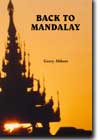| Our Publications | ||
| Books by Title | ||
| Books by Author | ||
| Books by Country | ||
| E-books | ||
| About | ||
| Orchid Press E-books | ||
| Distributed E-books | ||
| Our Bookshop | ||
| About Us | ||
| Browse Shop | ||
| How to Buy | ||
| Contact Us | ||
| WE BUY BOOKS AND LIBRARIES | ||
|
||
Book Reviews

Back To Mandalay
An Inside View of Burma
byGerry Abbott
2nd edition 2004. 203 pp., 18 ill., 2 maps, bibliography, 215 x 152, softcover.
ISBN-10: 974-524-042-7 $23.00
ISBN-13: 978-974-524-042-1
Mandalay UNCHANGED
Book review Michael Smithies,
(The Nation, 22 February 2004)
Old-timers may recall that Gerry Abbott in 1960 was busy teaching English at a teacher training college in Thonburi. He then moved on for a British Council stint in Jordan and subsequently took up an appointment with Manchester University. Secondments took him to Uganda, Yemen, Sarawak, Pakistan, Cameroon and Burma, this last in time to participate in some degree in the events of 1988 as seen from the perspective of Mandalay. He retired from English teaching in 1992 to concentrate on writing about Burma. This book follows the path, perhaps unconsciously, set by Dennis Enright’s “Memoirs of Mendicant Professor” or Harold Forster’s “Flowering Lotus”, set in 1950s Java - that of the expatriate teacher of English plonked down in some outlandish spot and supported (in theory at least) by the British Council and/or the British Embassy.
So we have a series of vignettes of expatriate life in the Burmese outback, where housing problems and administrative concerns inevitably figure large. These are varied and enlivened by asides concerning the history and culture as witnessed in daily life and the monuments so generously scattered around the environs by previous dynasties. Readers may not gain an overall perspective on Burma’s past and present that is not the intention, and can be found in Abbott’s “Inroads in to Burma” (1997) and “Traveller’s History of Burma” (1998) - but obtain instead little snapshots of daily life in what were sometimes (often erroneously) known as “hardship posts”.
Not much seems to have been changed for this second edition. The “Dear Reader” section is dated 1990 and the most recent book in the bibliography appeared in 1991. There is a brief postscript also dated 1991, bringing political events up to that year but not beyond, and linking the Burmese massacres of 1988 to those in Tienanmen Square. Ne Win has departed, but we are brought no further into time present, perhaps deliberately, since nothing seems to be resolved on that front.
On the professional side, one wonders how much could really be accomplished in any of these “hardship posts”. Local administrations cherished their prerogatives and saw little need to change. The standards were often abysmal; even the Burmese apparently called the BA (English) the ABC (English) degree, and the BSc in Mathematics the 123 (Maths), with - it was said - a gold medal going to anyone who failed the compulsory English exam for all students. But having an overseas lecturer constituted “a foot was in the door”, which by some mysterious process meant that influence, of some kind, was somehow, eventually, and hopefully, obtained.
Reading the book, memories of past trips to Burma flood back. Abbott found the venerable Strand Hotel rooms lacking every facility; in the mid-1970s this reviewer found the same, with the addition of rats scuttling across the dining room floor (things have since been totally overhauled).
There was always the hazard of flying the local airline, and when one arrived (phew!), came the hassle of obtaining a pre-booked room (again this reviewer remembers having to sleep, rather uncomfortably, on the billiard table at the then only hotel in Pagan for want of anything better).
This is an easy read, with much emphasis on the good things in life like food and drink, an occasional lapse into near-ribaldry, and enlivened by some stunning photographs. A glossary of Burmese terms used would have been useful, though: what does “they shikoed” mean?
[Read a review from The Journal of the Siam Society] [More Orchid Press Reviews]
PO Box 70, Trinity TB, NL, A0C 2S0, Canada
Telephone: +1 709-330-4703